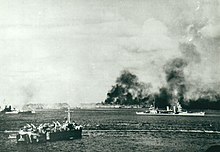Battle for Angaur
| date | September 17th to 30th, 1944 |
|---|---|
| place | Angaur , Palau Islands , Pacific |
| output | American victory |
| Parties to the conflict | |
|---|---|
| Commander | |
|
Inoue Sadae |
|
| Troop strength | |
| 81st Infantry Division | 1 battalion (approx. 1400 soldiers) |
| losses | |
|
260 dead, 1,354 wounded |
1,338 dead, 59 prisoners |
The Battle of Angaur was fought during the Pacific War from September 17 to 30, 1944 on the island of Angaur , part of the Palau Islands . It was part of the Battle of the Palau Islands and took place at the same time as the Battle of Peleliu (September 15 to November 25, 1944).
prehistory
Angaur is a small island of volcanic origin that is only five kilometers long and ten kilometers away from the neighboring island of Peleliu . The population lived from agriculture, fishing and the mining of phosphate . In mid-1944 the approximately 1400 soldiers of the 1st Battalion of the 59th Infantry Regiment of the Japanese Army were stationed on the island under the command of Major Ushio Goto. This unit belonged to the Japanese 14th Division , whose commander Lieutenant General Inoue Sadae was the commander in chief of the Palau Defense Sector.
The weak fortifications on the Palau Islands and the possibility of building an airfield made the archipelago an attractive target for the Americans after the conquest of the Marshall Islands ; however, due to the lack of landing craft, such an operation could not begin until the Mariana Islands were fully secured.
Landing and fighting on Angaur
On September 11, the battleship USS Tennessee began bombing Angaur, along with a number of cruisers and SBD Dauntless naval bombers from the carrier USS Wasp . Seven days later, on September 17th, the US 81st Infantry Division under the command of Major General Paul J. Mueller went ashore in the northeast and southeast of the island. Mines and the overcrowding of the landing zones with soldiers initially made the attackers more troubled than the Japanese counter-attacks. Resistance increased as the Americans advanced to The Bowl , a hill near Lake Salome in the northwest where the Japanese were planning to retreat. From September 20, The Bowl was repeatedly attacked by the 322nd Infantry Regiment, which, however, was unable to penetrate the cave-like interior of the base in view of the tough defense of the 750 soldiers equipped with machine guns , mortars and artillery . The fighting ability of the Japanese suffered more and more from hunger, thirst and the American grenade fire. Finally, the attackers were able to break into The Bowl on September 25th . Instead of taking the caves in battle, the entrances were simply bulldozed . By September 30, the Americans had control of the island.
Construction of the runways had begun during the battle. The delay in the battle for the Palau Islands made it impossible to use the airfields for the reconquest of the Philippines . Admiral William F. Halsey had deemed the action unnecessary prior to the invasion of the Palau archipelago, and military historians today share this view, arguing that the only benefit the battle had for the Americans was the combat experience gained by the 81st Infantry Division.
Immediately after the battle, the 81st Division was relocated to Peleliu to support the 1st Marine Division , where bitter resistance made the Marines in the central highlands of the small island to create. The 323rd Regimental Combat Team (RCT) had been assigned to occupy Ulithi Atoll after the first phase of fighting on Angaur, during which it was held in reserve .
Web links
- Robert Ross Smith: The Approach to the Philippines . United States Army in World War II, The War in the Pacific. (Chapters XXI and XXII )
- Western Pacific, June 15, 1944 - September 2, 1945 . US Army Campaigns of World War II brochure.

